I’ve come to feel increasingly inhibited and frustrated by the insistent pounding of the rhythm section. With it, it’s impossible for the listener or the soloist to hear the horn’s true sound, I’ve come to believe, or fully concentrate on the solo line. An imbalance of advances has moved the rhythm from a supporting to a competitive role.
-Jimmy Giuffre
In the article Requiem for Lennie from the March 1989 issue of The Wire magazine Brian Priestly wrote:
Tristano’s music was sufficiently of its time to have acquired by now the respectability of age. Even if “period charm” is not exactly the phrase that comes to mind most readily, his determinedly different style has some of the quaint wrongheadedness of some other specifically white developments, such as Stan Kenton’s. And certainly, his attempt at “white bebop” has more going for it than oh-so-palatably West Coast stuff that stole the limelight soon after.
I took exception to the article and wrote a letter to The Wire claiming that Tristano’s “wrongheadedness” was his virtue and that limiting the freedoms of the rhythm section was key to focusing attention on the soloist's improvisation and melodic or contrapuntal lines. Tristano was moving away from the emotional bebop style of that time famously saying it’s “all emotion, no feeling.” Since The Wire published my letter in their April 1989 issue, I felt somewhat vindicated. More importantly, I was glad I stuck up for Tristano.
Like Tristano, Jimmy Giuffre had trouble with intrusive rhythm sections and was a strong individualist out of place in the strangeness between the modern jazz of the 1940s and freer forms of the late 1950s and later.
This week on that Big River called Jazz we dig in our paddles to discover the world of Jimmy Giuffre.
In 1870, the directors of the St. Paul and Sioux City railroads chose the future townsite of St. James, Minnesota as the midpoint for a new railroad linking the two cities. The following year St. James was incorporated and twenty-three years later, American composer, teacher, and author Wesley La Violette was born there.
He was raised in Spokane, Washington, and graduated in 1917 from Northwestern University in Chicago with a degree in music, which he completed in only two years. He served with the U.S. Army in France during World War I and subsequently attended the Chicago Musical College, where he earned a doctorate in music in 1925. He was later appointed the college’s dean and head of the Department of Theory and Composition. He also taught at De Paul University’s School of Music from 1933 to 1940.
Dr. La Violette later settled in southern California and taught at the Los Angeles Conservatory where he lectured on philosophy, religion, and the arts. He also taught music privately and became an important figure on the West Coast jazz scene of the 1950s. He was a highly respected teacher who greatly influenced several of his students including Shorty Rogers, John Graas, and perhaps his greatest pupil Jimmy Giuffre.
Giuffre was born in Dallas, Texas, and took up the clarinet at nine. He studied music at North Texas State Teachers College, worked in dance bands and classical ensembles, and spent four years in an Air Force orchestra. He studied composition in California in the late 1940s and soon began arranging for Boyd Raeburn’s innovative dance band and the big bands of Jimmy Dorsey and Buddy Rich.
He became famous for his work with Woody Herman’s orchestra. In Hollywood on December 27, 1947, Herman recorded Giuffre’s hit song Four Brothers:
In Joseph Kastner’s 1973 book The Swing Era – Into the 50s, Jimmy Giuffre summarized his experience with Herman when that tune was composed. He made sure to first give credit to composer, arranger, and multi-instrumentalist Gene Roland for his role in experimenting with various tenor saxophone combinations. Roland played piano and wrote for Woody Herman's Second Herd, a group in 1946 that included the Four Brothers: Stan Getz, Zoot Sims, Serge Chaloff, and Herbie Steward. Giuffre recalled:
Gene was in New York in the late 1940s, and would hang out at a place called Nola Studios, where all the bands rehearsed and musicians met. For some reason, there were a lot of good tenor players around, there must have been a hundred of them. The usual sax section at the time was two altos, two tenors, and a bari. Gene decided to write a four tenor sax piece. He liked the sound very much and everybody did. When he came out to Los Angeles, we got together a band with four tenors.
Woody said to me: “Why don’t you write a piece featuring the four-sax sound?” I did, and called it “Four Mothers.” Woody changed that to “Four Brothers.” It took months before the band could play it right. Though it’s a four-tenor sound, Herman didn’t use four tenors (in that band), so it was played by three tenors and a baritone. He later used the Four Brothers sound all through his Third Herd repertory.
In the early 1950s, the West Coast, with its Jazz workshops and experimental groups, was becoming an increasingly important center of modern jazz. One school was driven by Shorty Rogers, Shelly Manne, and Jimmy Giuffre - and Dave Brubeck before them. In the liner notes to the Contemporary album Shelly Manne & His Men recorded at Radio Recorders Studios in Hollywood on July 20, 1953, Nesuhi Ertegun argues that one of the most significant elements in their approach is the elevation of the composer-arranger to equal status with the solo improviser. He goes on to write:
Today’s young writer is thoroughly familiar with classical music, especially when it’s contemporary… From the jazz tradition he accepts much and rejects much… His masters, then, are as much Bartok or Schoenberg as Count Basie or Charlie Parker. He is a new kind of composer, who doesn’t accept arbitrary separations between jazz and classical music, who feels strongly he is writing modern music, open to all musical currents, whatever their source. He doesn’t want his music to be categorized, because his interests and training aren’t; he wants to stand or fall as a composer.
From that album, Giuffre’s Fugue is a good example of the type of modern jazz these composers were after:
One month later on August 31, 1953, in Hollywood Giuffre recorded on Teddy Charles Collaboration West, released on Prestige label:
The song Margo is wonderfully introspective and gives us a taste of what’s to come:
In 1954, Capitol Records gave Giuffre his first record date as a leader with Giuffre on tenor, baritone sax, and clarinet, Bud Shank on alto, Bob Enevoldson on bass trombone, Shorty Rogers on flugelhorn, Jack Sheldon on trumpet, Russ Freeman on piano, Curtis Counce on bass, and Shelly Manne on drums:
Although it was recorded in Hollywood in February and April of 1954 with a spirited group of solid West Coast jazzmen, except for Sultana this is a pretty basic West Coast affair and still not that far removed from Gerry Mulligan’s pianoless Quartet with Chet Baker.
In between his two Capitol releases, on September 10, 1954, in Hollywood, Giuffre recorded in a trio format with Shelly Manne on drums and Shorty Rogers on trumpet. The album was released on the 10” format as Shelly Manne Vol. 3 “The Three” for Contemporary label:
This is perhaps the most experimental West Coast album to date. It featured Rogers’s twelve-tone row composition Three on a Row and simultaneous improvising on Giuffre’s Abstract #1:
For his second Capitol album Tangents in Jazz, Giuffre paired down his unit to a quartet with Jack Sheldon on trumpet, Ralph Pena on bass, and Artie Anton on drums:
Although the album leaves more space for the solo instrument, I find only a couple of songs on Side 2 (The Leprechaun and Rhtoric) demonstrate any real jazz tangent toward a more third-stream approach. However, when Giuffre was given the chance to record by Atlantic Records in 1956, he finally started to question jazz orthodoxy.
His Atlantic debut The Jimmy Giuffre Clarinet was recorded in March 1956:
This is a fantastic album. Giuffre opens up the album with his wonderful So Low accompanied only by his foot tapping:
The second track is a nice clarinet and celeste duo rendering on the jazz standard Deep Purple. Interestingly, the album starts with a solo clarinet with foot tapping on So Low and ends the same way on Down Home. A nice touch. This is a highly underrated album that deserves wider recognition.
In 1957, on his second Atlantic album, Giuffre took another step away from jazz orthodoxy and not only did away with the piano but also did away with the drummer. The Jimmy Giuffre 3 was his first drummerless trio with Jim Hall on guitar and Ralph Pena on bass:
This group played what Giuffre called “blues-based folk jazz.” However, other than the trio format and when they’re not playing blues tunes (two of the longest songs), I think the album still has the same feel as those earlier Mulligan Quartet records - just a little quieter. I will say though that it is interesting to hear the jazz standard The Song Is You played in this trio format.
That same March 1989, The Wire issue included Graham Lock’s terrific article coming in from the cool. Along with Phil Freeman, whose recent deep and fantastic book In the Brewing Luminous: The Life and Music of Cecil Taylor, Lock is my favorite jazz writer. In the article, Guiffre shared how he decided on this trio unit:
It came out of Debussy, actually, Debussy’s sonata for flute, viola, and harp. So Jim was the harp, Ralph the viola, and I was the flute. I’d been looking for someone who could play great drums and also wanted to play more chamber-type music - and it was hard. I couldn’t find a drummer interested in playing softly, in listening and resting. So I heard this Debussy piece, I liked it, and I thought, well why not the three of us.
Here is Debussy’s Sonata for Flute, Viola, and Harp (1915):
On his 1958 Atlantic album Trav’lin’ Light, Giuffre’s instrumentation underwent an even more radical change when valve-trombonist Bob Brookmeyer replaced Ralph Pena’s bass. Now he is leading a trio with no piano, drummer, or bass!
On this album, I think Giuffre finally starts to feel comfortable with what’s going on in his head with the music. For example, a song like The Green Country (New England Mood) foreshadows the type of wonderful introspection that would be coming in a few years:
For me, with this trio unit, Giuffre gets further away but still hasn’t quite shed that Mulligan Quartet feel. This is not said to imply my dislike for the sound, on the contrary, the ability to focus on the instruments and interplay without the rhythm section is refreshing, but it’s still not altogether liberating.
Here’s one more for the road. In 1961, Giuffre led a trio with Paul Bley on piano and Steve Swallow on bass which was the beginning of the most adventurous music of his career. In that year, this trio released two excellent albums Fusion and Thesis both released on the Verve label. On both albums, Giuffre featured some Carla Bley compositions, like the wonderful Jesus Maria from Fusion:
You can read more about Carla Bley here:
The final album by this trio was Free Fall released by Columbia in 1963. in 1998, Columbia released a CD with five previously unreleased solo tracks at the end. I actually find the final four tracks the best - a kind of four-song solo clarinet suite: Future Plans; Past Mistakes; Time Will Tell; and Let’s See. Here is Time Will Tell:
It had been a long journey, but with Free Fall the Texan Giuffre had finally lost that “Down Home” feeling he had carried with him since playing with Woody Herman’s band; however, he was not able to record again for nearly ten years. The music business gave him the cold shoulder - the leader of the West Coast cool school was run out of town by the jazz police.
In a June 1955 article for Metronome magazine, Giuffre shared, “Forget tradition and what has been done before and what should be done… Allow people to be innovators… Let each artist find and use his own means of expression. Let’s emphasize individual creativity.”
I love how Giuffre concentrated on creating artistic statements that reflected his belief in the teachings of his mentor Dr. La Violette and not the fashions of the day, but unfortunately, that may have come with a cost.
In that same The Wire article, Graham Lock wrote:
Someone must have been telling lies about Jimmy G for without him doing anything wrong his career was arrested one fine morning.
Club-owners shunned him; record companies didn’t want to know him; compositions gathered dust on his shelf. From being a successful, acclaimed musician he found himself edged farther and farther from the scene until, finally, he had to take a teaching job to pay the rent. Without a trial, without charges being brought, Jimmy G was sentenced to silence.
And later in the article:
Ask him what he thinks lay behind that Kafkaesque blackballing… he’ll say, with a mild shrug, “Well, I got into the free jazz.” Long pause. “and I didn’t use any drums.” Long pause. “So…some people didn’t think it was jazz.”
Ah. Someone must have called the Jazz Police.
In his book West Coast Jazz, Ted Gioia perhaps said it best, “Being ahead of his time meant, for Giuffre, being shut out of his own time.”
Next week on that Big River called Jazz, we’ll dig our paddles into the waters of Italian singer Daisy Lumini.
Please hit this link to buy me a cup of coffee, if you’d like to show your guide some appreciation for this and past journeys. Know in advance that I thank you for your kindness and support.
If you like what you’ve been reading and hearing so far on our journey and would like to share this with someone you think might be interested in learning more about our great American art form: Jazz, just hit the “Share” button.
From Astaire to Sun Ra: A Jazz Journey is a reader-supported publication. If you feel so inclined, subscribe to my journey by hitting the “Subscribe now” button.
Also, find my playlist on Spotify: From Fred Astaire to Sun Ra.
Feel free to contact me at any time to talk shop. I welcome and encourage that.
Until then, keep on walking….


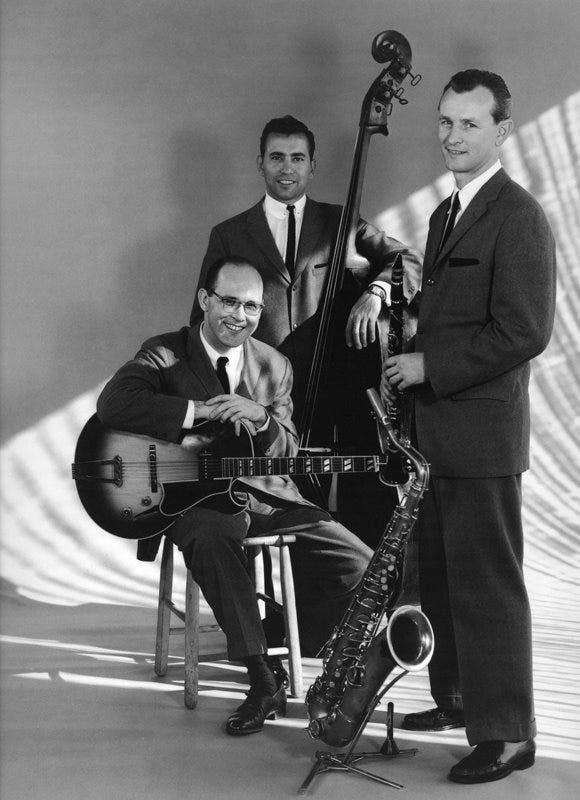



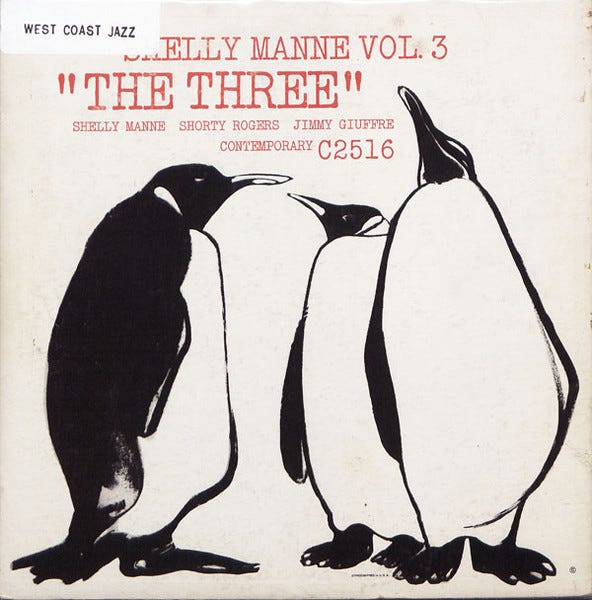
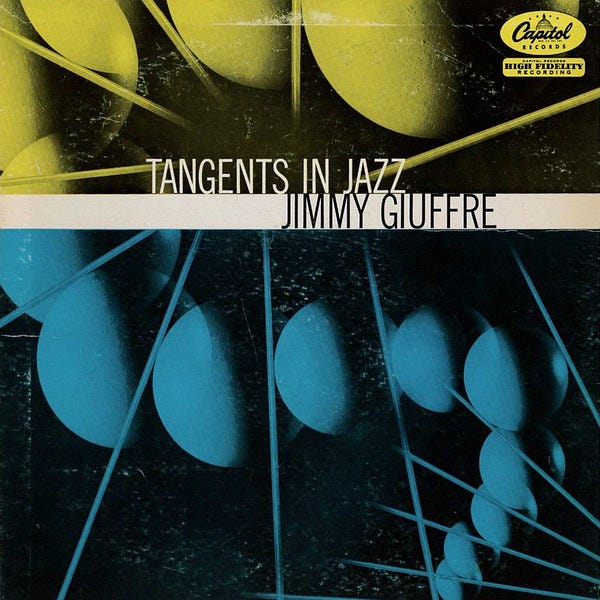
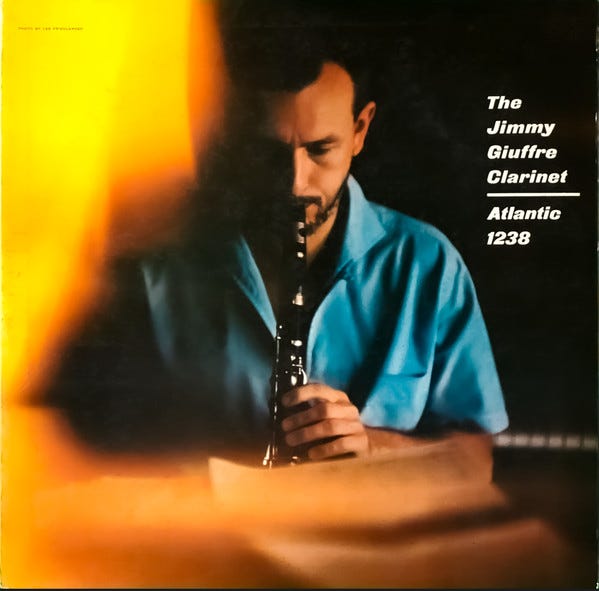
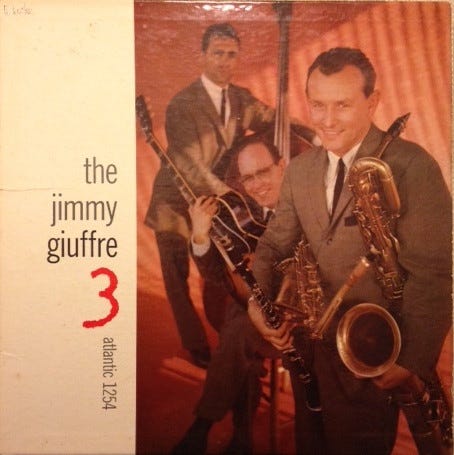

Thanks for this comprehensive resumé. Not sure about the role of the "jazz police," though, unless the term includes the vagaries of taste and the demands of the saloon business. Steve Swallow has said the trio with Giuffre and Bley succumbed to a lack of interrest: not enough fans would come out to hear them and as a result they couldn't get booked anymore. They weren't arrested by the jazz police so much as being truly ahead of their time.
4 Brothers, imagine that. Thanks Ty.